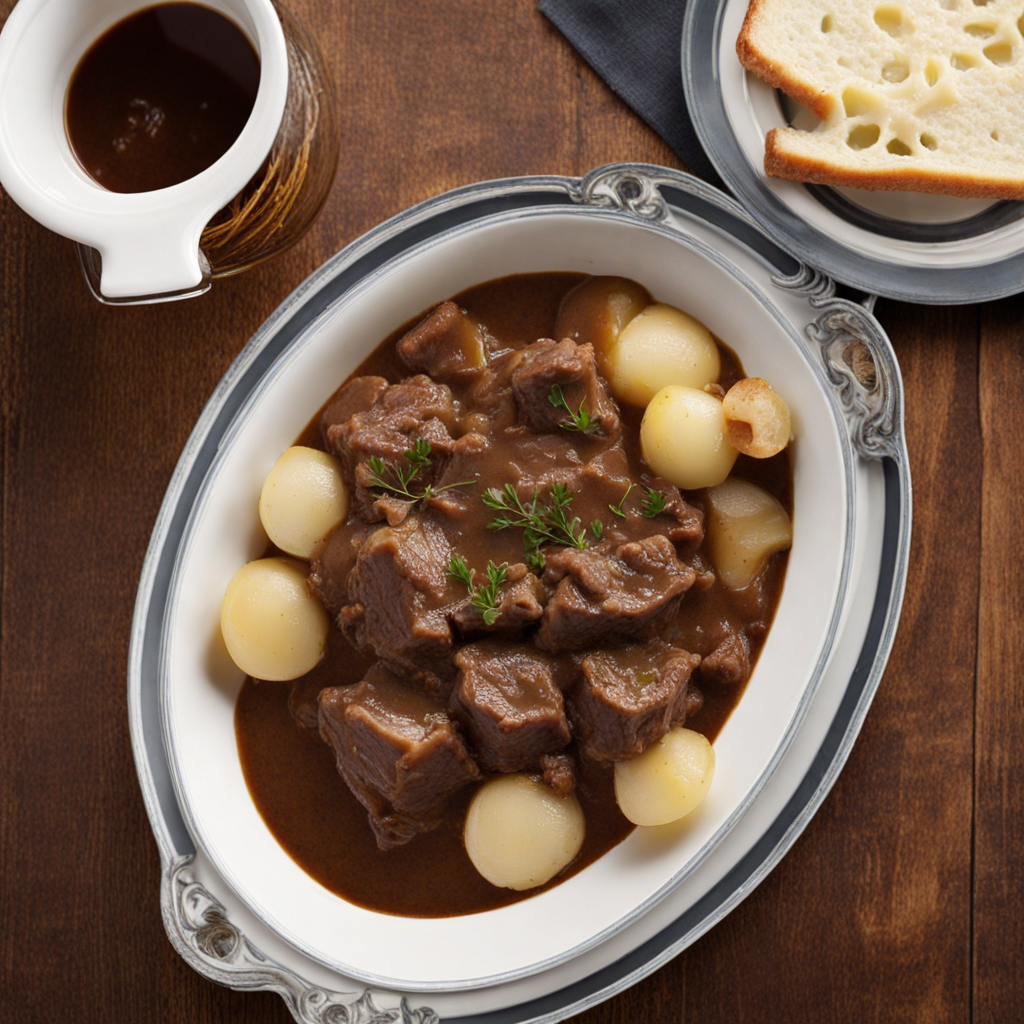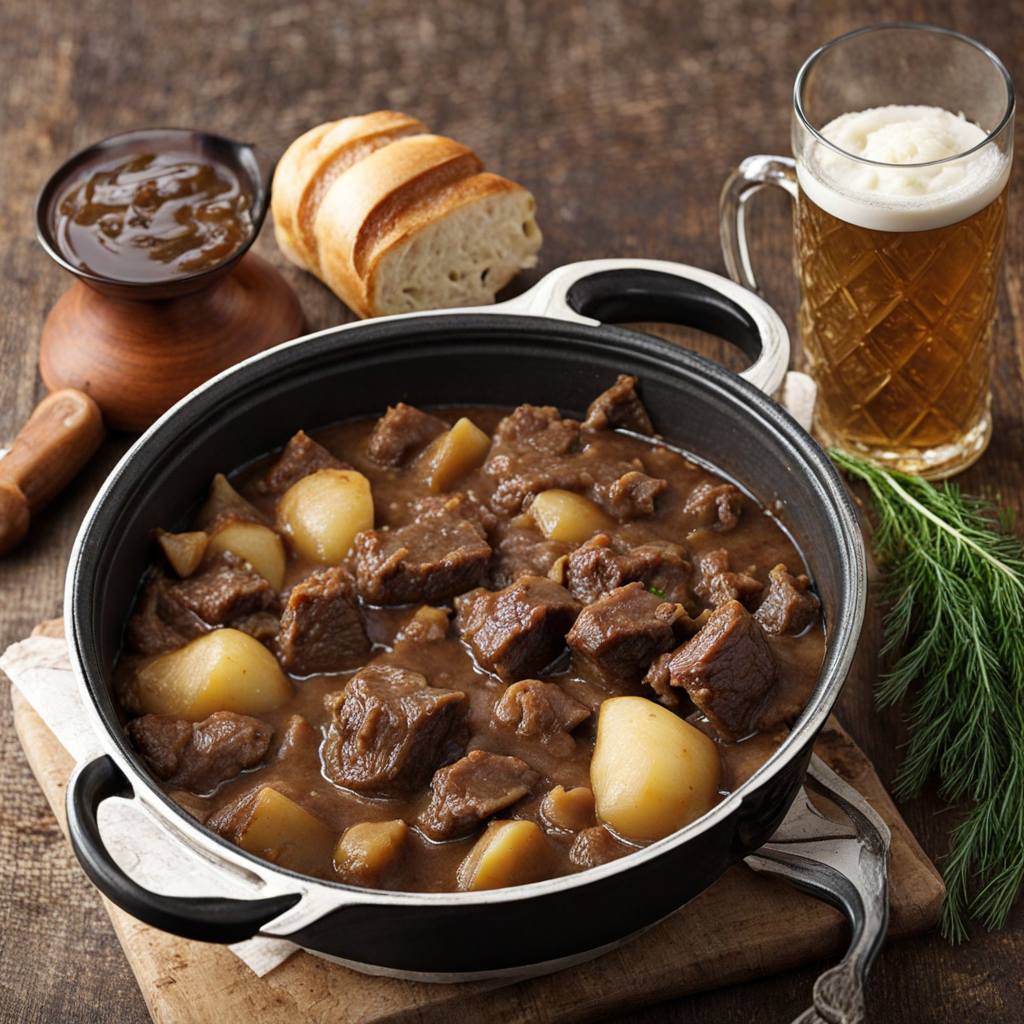Carbonnade flamande
Carbonnade flamande is a traditional Belgian dish that embodies the rich flavors and comforting essence of the country’s culinary heritage. This hearty beef stew is prepared by braising chunks of beef in a luscious mixture of dark beer, typically a Belgian ale, along with onions, and a hint of mustard. The slow cooking process allows the meat to become incredibly tender while absorbing the complex flavors of the beer, creating a deep, savory sauce that is both satisfying and aromatic. The sweetness of caramelized onions balances the deep, malty notes of the beer, and the addition of spices such as thyme and bay leaves infuses the dish with warmth. Sometimes, slices of bread are added to the pot, absorbing the sauce and adding a delightful texture. This melding of ingredients results in a dish that is not only rich in flavor but also evokes a sense of rustic comfort, perfect for sharing during colder months or festive gatherings. Served typically with a side of fries or creamy mashed potatoes, Carbonnade flamande invites you to experience the essence of Belgian cuisine. Each bite offers a symphony of flavors, from the tender beef to the slightly sweet and tangy sauce, making it a true delight for anyone looking to explore new culinary landscapes. This dish is a testament to the art of slow cooking, where simple ingredients come together to create a memorable and hearty meal that speaks to the soul.
How It Became This Dish
The History of Carbonnade Flamande: A Belgian Culinary Gem Origins and Early History Carbonnade flamande, a rich and hearty beef stew, stands as a testament to the culinary traditions of Belgium, particularly the Flanders region. Its roots can be traced back to medieval times when stews were a common method of preserving meat and maximizing flavor. The word "carbonnade" is derived from the French term "carbon" which means "charcoal," suggesting that this dish was originally cooked over an open flame, likely in a communal hearth. The use of beer in the preparation of carbonnade flamande links it to the brewing culture of Belgium, which has flourished since the Middle Ages. It is believed that the dish may have evolved from older recipes that utilized beer as a cooking liquid, a practice that made use of the local agricultural products and the abundance of breweries in the region. Cultural Significance Carbonnade flamande is more than just a meal; it embodies the spirit and culture of Flanders. In a region known for its rich agricultural heritage, the dish reflects the abundance of local ingredients—beef, onions, and, most importantly, beer. It acts as a culinary canvas for the flavors of the region, showcasing the combination of sweet, savory, and slightly sour notes that characterize many Belgian dishes. The dish is traditionally enjoyed during the colder months, making it a staple in Belgian households, particularly during family gatherings and festive occasions. In Flanders, sharing a hearty meal like carbonnade flamande fosters a sense of community and togetherness, reflecting the region's values of hospitality and camaraderie. Development Over Time As Belgium's culinary landscape evolved, so did carbonnade flamande. Different variations emerged, influenced by local ingredients and regional preferences. The classic preparation involves browning chunks of beef, typically from the shoulder or chuck, in a pot, then simmering them with sliced onions, brown sugar, mustard, and a robust dark beer—often a Flemish ale or a brown beer like "Duchesse de Bourgogne" or "Leffe Bruin." Over the years, the dish has incorporated various additional ingredients, including herbs such as thyme and bay leaves, as well as vegetables like carrots and mushrooms. Each family and chef has their unique take, often passed down through generations, adding personal touches that reflect regional and familial traditions. The influence of the French and Dutch kitchens on Belgian cuisine cannot be understated. During the 19th century, as Belgium underwent political and social changes, the blending of these culinary traditions led to the refinement of dishes like carbonnade. The French, with their emphasis on technique and flavor layering, contributed to the sophistication of Belgian dishes, while Dutch influences brought additional ingredients and preparation styles. In the 20th century, as Belgium gained international recognition for its culinary prowess, carbonnade flamande was embraced by chefs seeking to highlight native ingredients and traditional recipes. The dish became a symbol of Belgian gastronomy, celebrated not just in homes but also in restaurants and bistros across the country. Modern Variations and Global Influence In contemporary cuisine, carbonnade flamande has experienced a renaissance, finding its way onto menus far beyond Belgium. Chefs around the world have adopted the dish, often putting their spin on it by experimenting with spices, types of beer, and cooking methods. Some variations include adding chocolate for a deeper flavor profile or incorporating smoked meats for an enhanced umami experience. Moreover, the modern emphasis on farm-to-table dining has led to a resurgence in the use of locally sourced, sustainable ingredients in preparing carbonnade flamande. This trend reflects a growing appreciation for the dish's rustic origins while also aligning with contemporary culinary values. As Belgium continues to promote its gastronomic heritage, carbonnade flamande is celebrated at festivals and food events, where chefs showcase their interpretations of this classic dish. The annual "Belgian Beer Weekend" in Brussels, for example, highlights the synergy between Belgian beer and traditional dishes, and carbonnade flamande often takes center stage. Conclusion: A Culinary Bridge Between Past and Present Carbonnade flamande is more than just a dish; it is a narrative woven into the fabric of Belgian culture. It tells the story of a region steeped in history, where agricultural abundance and brewing traditions converge to create a beloved comfort food. As it has evolved over the centuries, the dish has retained its core elements while adapting to modern tastes and culinary innovations. Today, when one savors a bowl of carbonnade flamande, they are not just enjoying a meal; they are partaking in a culinary tradition that bridges the past and the present. It is a dish that invites us to gather around the table, share stories, and appreciate the rich flavors and history that Belgium has to offer. Whether enjoyed in a cozy tavern in Bruges or prepared in a home kitchen in New York City, carbonnade flamande continues to warm hearts and nourish souls. As it stands, carbonnade flamande represents a microcosm of Belgian identity—rooted in history, enriched by culture, and celebrated for its flavor. It remains a dish that resonates with anyone fortunate enough to experience its deep, comforting embrace, ensuring that its story will continue to be told for generations to come.
You may like
Discover local flavors from Belgium







